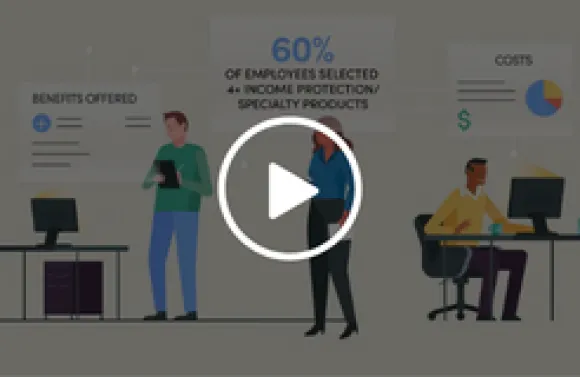
Just a couple years ago, employers faced the challenge of balancing the need to control costs and attract and retain talent in a competitive job market. Last year, the year of COVID-19, employers were forced to consider the financial impact of a pandemic on top of protecting employees’ total wellbeing. At the same time, many employers had to conduct their first-ever all virtual benefits enrollment process.
So, how, and to what extent, did these impact employee benefit trends?
To answer this question, we looked at anonymous data across four open enrollments, 343 large employer customers, and 3.5 million consumers on our platform. This led to unique insights into trends, both before and during the pandemic.
So, what did we find?
Overall, we found that employers recognize that they must meet their employees where they are with what they need. That’s a bit of an oversimplification, so let’s dig deeper.
Expanded benefit offerings
Employers continued the trend of shifting away from single health plan strategies with nearly three quarters offering at least one HDHP and one PPO in 2021 – up from 65 percent in 2018.
Voluntary and specialty benefit offerings continued to grow through the onset of COVID-19 as part of the employer effort to protect employees against unexpected expenses, to support employee total wellbeing, and to enhance total compensation in order to protect and support employee financial wellbeing.
Higher adoption of consumer-driven health plans
PPOs are still the most popular choice among employees, likely due to the limited out-of-pocket exposure. However, HDHPs are catching up with a 30 percent increase in participation since 2018. This trend is being driven primarily by younger employees who are likely healthier and attracted by the lower premiums.
Following the growth in HDHP adoption, more that 90 percent of eligible HDHP subscribers opted into an HSA in 2021. This trend is again most influenced by youth. Employee HSA contributions, like participation, have grown over the last four years, with the highest growth rates among younger generations – specifically millennials.
A shift in health plan premium cost-sharing
Employees only saw slight increases in health plan premiums for all plan types, despite expected spikes as a result of COVID-19. This was largely due to employers taking on a greater percentage of the premium share in 2021 for both HDHPs and PPOs.
Increased voluntary benefits participation
As employers made more voluntary benefits available, employee participation grew in both income protection and specialty voluntary benefits. In fact, hospital indemnity participation more than doubled since 2018!
As a result of increased opportunity and familiarity, employees are selecting more voluntary benefits overall – 60 percent of employees who selected voluntary benefits opted in four or more voluntary benefit products in 2021, which was in 2018 where 60 percent were selecting four or less products.
The data has shown us that benefit offerings and enrollment trends have not shifted far from previous years. Employers took on the financial responsibility of absorbing health plan costs while offering more benefits in order to establish consistency for employees while the impact of COVID-19 is still a question mark. Taking advantage of the opportunity, employee participation in health care savings and income protection benefits continued to grow.
Download the Benefitfocus State of Employee Benefits 2021 report for more insight into benefits plan design and enrollment trends.


